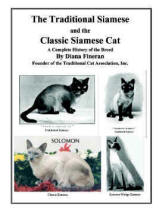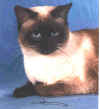|
Q: What are the Traditional Siamese and the Classic Siamese Cat?
A: These are the pointed cats with a striking difference between their
body color and their point color. Accented by brilliant blue eyes, they
are a very regal cat. The Traditional Siamese and the Classic Siamese preserve
the old, original body types that came out of Siam. They are typically
calm, affectionate cats who live well into their teens. Over 20 is not
unusual. One Traditional Siamese was reported to me to have lived to 24
1/2!
|
An example of a good profile with
Tarrahs Shades of Bonnie Blue
Courtesy of C. Eloise Smith |
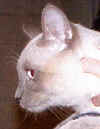
|
A good Example of Traditional Siamese Males
|
 |
Rising Star Goliath of Neko Sumai
From our 2005 TCCR Show |
A good Example of Traditional
Siamese Females
|
Alisa of Neko Sumai
From our 2005 TCCR Show
|
 |
|
 |
Tarheel's Ming Tai
From our 2005 TCCR Show |
|
|
|
|
|
|
Of all the cat breeds the "Siamese" has endured the most prolonged and
the most horrific damage and persecution by other cat associations
world wide. For over 100 years now the breed has been changed and changed
and changed again. The resulting "show Siamese" of today resembles its
forbears only in color! When I started TCA, Inc. in 1987 I became aware
that the breed had two different types within it at that time. Over a period
of two years, after many letters and photos from breeders from all over
the world, I slowly began to see there was a third type. To support the
old, original types I created the breed names, "Traditional Siamese" and
"Classic Siamese" and I wrote and hold Copyrights to these breed names and to the very first Breed
Standards ever written for the Traditional Siamese and the Classic Siamese.
In brief here is a description of the three types in existence today. I also
created and hold Copyrights to the breed names of "Old Style Siamese", "Original
Siamese", "Old Fashioned Siamese" and several others I use for the same types. The Traditional Siamese has a round head, and a large, muscular, stocky
body.
The Classic Siamese has a WIDE wedge shape to its head, with a slightly more elongated body, legs and tail than the Traditional Siamese. It is
still a large, well muscled cat.
|
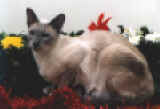
|
Click on the small Picture
to Enlarge |
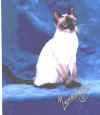
|
The Extreme Wedge Siamese has a head shaped like a piece of pie, very
sharp and pointed. This is accented by huge ears. The eyes are so set on
a slant that they are mere slits on the side of the head. The rest of the
body is long, thin, tubular and often emaciated looking. They are a man
made, genetically engineered derivative of the original "Siamese". In fact
they should be re-named to something like Thai Cats with no reference
to "Siamese" in their name. They do not represent the most important attributes
of the breed at all. Due to a reduced immune system from years of inbreeding,
they live from 2 to 5 years of age. A long medley of genetic problems such
as cardiomyopathy, kidney disorders and pancreatitis saturate this type.
Only a few remaining bloodlines are still healthy. THE TRADITIONAL CAT
ASSOCIATION, INC. DOES NOT SUPPORT THE EXTREME WEDGE SIAMESE.
Q: What colors do they come in and what are points?
A: The accepted colors by TCA, Inc. are Seal Point, Chocolate Point,
Blue Point, Lilac Point and Albino. The points refer to the face, ears,
paws and tail. These are the areas that are colored with a darker color
than the rest of the body. For instance a Seal Point has dark brown points
and a light cream colored body. A Blue Point has bluish gray points with
an almost white body color.
|

Click on picture to enlarge
Photo Copyright J. Child |
Q: What is their personality like?
A: The Traditional Siamese and the Classic Siamese are highly intelligent,
people centered cats, who enjoy being the center of attention. Visitors
to our home are always greeted at the door with a warm, friendly welcome.
Highly conversational, they will "talk" to you, affectionately telling
you about their day. They are companion cats who love to fetch, can be
taught to walk on a leash, and enjoy cuddling with you. Children and other
family pets are accepted with tolerance. Small children are allowed to
take liberties (not ill treatment, however) that they will not take from
adults. When they have had enough they just make themselves unavailable.
Usually they sheath their claws when playing with people. They can be easily
trained to use a cat scratcher.
I can say they are very good with dogs. Every dog we have owned has
been raised by our cats. This establishes the hierarchy early on, which
the dog never questions. In fact each dog has grown up to be not only our
guardian, but a protector of the cats as well. Our current Great American Mutt gets even by
tattling on them when they get in trouble. The good natured
comradery goes back and forth between them.
Q: Are they noisy?
A: Its voice is one of the traits the Traditional Siamese and Classic
Siamese are known for. They use their voice with many different intonations.
At times they are extremely loud when they really want to make a point.
A female in heat will continue her "calling" 24 hours a day, so TCA, Inc.
always encourages the spay/neutering of pets for the family. While on the
phone your friends may ask if you have a baby crying in the back ground.
Since the Traditional Siamese and
Classic Siamese are calmer and not hyperactive
as the Extreme Wedge Siamese, they are a bit less vocal. Still some are
non-stop talkers. Others talk only when they have something important to
say. This is apparent from kitten hood, so a buyer can tell what they are
getting.
Q: How many should I have?
A: Single cats can do fine, but at least two is best. They love company,
so two keep themselves content when you are gone. Expect to be greeted
at the door with a lengthy conversation from your single cat, for you are
its focus. Two will tell you about their adventures as well.
Q: Will a male or female make a better pet?
A: It makes no difference between the two. Each, however, must be spayed
or neutered.
Q: Can I allow my Traditional Siamese and my Classic Siamese outdoors?
A: None of our breeders will sell to anyone who allows a pet outdoors.
With cars, diseases, dangers from dogs, other cats and wild children it
is no longer a feasible option to allow any cat loose out doors. Of course
you are most welcome to walk through your garden with your cat on a leash.
Fenced in yards must have a TALL fence with a section that leans inward
all along the top. This may keep your cat in, but it won't keep other cats
out, however! For any outdoor excursion in a fenced in yard supervision
is mandatory.
Q: Do they have any faults?
A: Crossed eyes have been a small part of the breed since its beginnings.
This offers no problem to the cat and is a mere fault, which our breeders
try to breed out. It will, however, pop up from time to time because it
is genetically there.
Kinked tails, also are a genetic part of the breed, which cause no problem
to the cat. Since some of our customers have always had "Siamese" with
crossed eyes and kinked tails, I have had them specifically ask for these
traits in the cat they purchase. It is all a matter of personal taste.
Q: How big do they get?
A: They compare nicely to the average cat. Males weigh from 10 to 15
pounds and females weight between 8 and 12 pounds.
Q: What care and training do they require?
A: Traditional Siamese and Classic Siamese are hardy cats with good
appetites. A high quality food recommend by the breeder is best. Even though
they don't shed excessively, they do enjoy being combed or brushed. This
becomes a daily ritual enjoyed by both cat and owner that removes excess
fur to keep it from ending up on furniture or clothing. Sexual maturity
comes at an early age for most "Siamese", therefore it is recommended to
have them spayed or neutered by the age of 6 months. Please follow your
Veterinarian's instructions.
|
HISTORY
|

Click on picture to enlarge
Photo Copyright J. Child |
The Traditional Siamese and Classic Siamese of today are the living
representatives of the first Siamese to be imported out of Siam (Thailand).
They existed in the same body styles for thousands of years, and were captured
in written testimonials, paintings and pictures verifying this. However,
the last 50 years has seen major changes in the animal kingdom where man
has changed the course of evolution. With these changes also came misrepresentations.
When I first chose to intervene on behalf of the Siamese cat, the magnitude
of lies and misrepresentations towards what I was trying to achieve grew.
At the urging of my husband, I pursued and suggested to my supporters,
that when confronted by outlandish statements of pretended fact, to request
the representative to prove it. Proof to be in the form of documentation,
cattery records, photos, names of owners and names of cats. Statements
such as, "everyone knows" or "this is common knowledge" were not acceptable
answers to a request for proof.
Following my own suggestion to others, I set out upon an 11 year long
journey through the WHOLE HISTORY OF THE SIAMESE BREED! My adventure lead
me through over 600 books, among all of the oldest Stub Books of the worlds
major Registries, and into the acquisition of hundreds of photographs. I
have created a data base and text that may very well be the most complete
and comprehensive history of the Siamese breed ever written. My goal was
to be as detailed, thorough, and complete with documented proof as it could
possibly be. It will silence the many untruths that have been written and
spoken over the past years. My book is over 960 pages with over 1200 photos and
illustrations, and is available at this website
https://book.traditionalcats.com .
Top of Page
Last Updated:
07/20/24 |
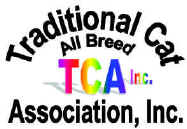
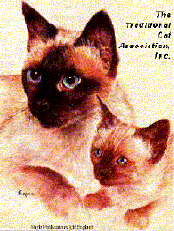 The
Traditional Cat Association,
Inc.©1987®TM
Official Website
The
Traditional Cat Association,
Inc.©1987®TM
Official Website